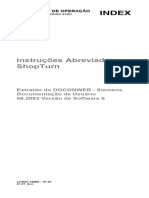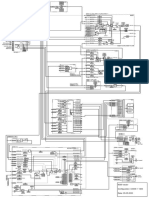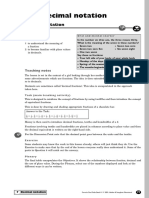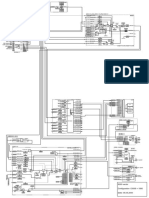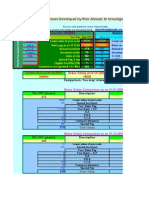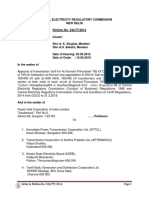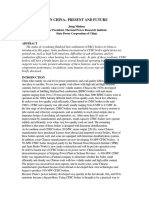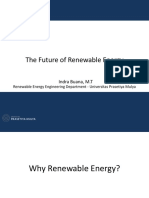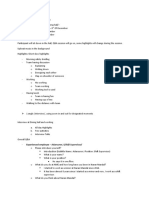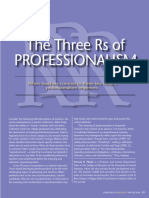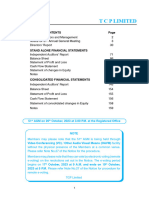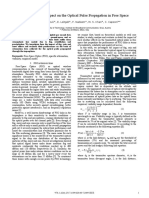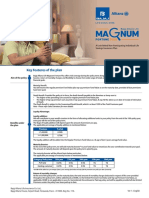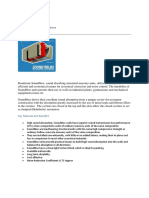T a b :
G e n . E x . & O p H a n d o u ts
L e a r n in g O b je c tiv e s
G o a l: T o u n d e r s ta n d th e b a s ic th e o r y o f S y n c h r o n o u s G e n e r a to r o p e r a tio n th r o u g h th e r o le p la y e d b y th e : P r im e M o v e r , E x c ita tio n S y s te m
a n d a tta c h e d L o a d .
L e a r n in g O b je c tiv e s : B y th e e n d o f th is m o d u le , th e p a r tic ip a n t s h o u ld b e a b le to :
1 . D e s c r ib e th e b a s ic o p e r a tio n o f a S y n c h r o n o u s G e n e r a to r th r o u g h th e r o le p la y e d b y th e : P r im e M o v e r , E x c ita tio n S y s te m
a n d a tta c h e d L o a d .
2 . E x p la in th e in fo r m a tio n d e ta ile d o n th e G e n e r a to r N a m e p la te a n d D e s ig n D a ta S h e e ts a s fo u n d in th e U n it In s tr u c tio n B o o k .
3 . R e a d a n d in te r p r e t G e n e r a to r D a ta C u r v e s :
A . V e e C u rv e s .
B . R e a c tiv e C a p a b ility C u r v e s .
4 . C o m p a r e a n d c o n tr a s t th e s e v e n in d iv id u a l E x c ita tio n S y s te m s .
5 . L is t th e r e q u ir e m e n ts th a t m u s t b e m e t to S y n c h r o n iz e a th r e e p h a s e S y n c h r o n o u s G e n e r a to r to th e P o w e r G r id .
O u tlin e
I. In tro d u c
A
B
C
tio
. R
. R
. S
II. G e n e ra
A
B
C
to r
. In
. G
. G
III. G e n e r
A
B
IV . P u rp o
G n _ E x _ S y s .d s f
P a g e
1 4 -S e p t-0 0
a to
. Is
. S
s e
e v ie w O b je c tiv e s
e v ie w O u tlin e
tu d e n t R e fe r e n c e M a te r ia l
T h e o
p u ts a
e n e ra
e n e ra
1 .
2 .
3 .
r O
o c
y n
o f
ry
n
to
to
V
C
N
d O u tp u ts
r In te rn a l
r - L o a d C h a r a c te r is tic s
e e C u rv e s
a p a b ility C u r v e s
a m e p la te D a ta
p e r a tio n
h r o n o u s O p e r a tio n
c h r o n o u s O p e r a tio n
E x c ita tio n S y s te m s
V . E x c ita tio
A .
B .
C .
V I. In d iv id
A
B
C
D
E
F
G
H
n R
D C
A C
R e
u a
. D
. C
. A
. A
. P
. G
. B
. E
e g u la
R e g u
R e g u
g u la to
to rs
la to r
la to r
r P r o te c tiv e F u n c tio n s
l E x c ita tio
C G e n e ra
o m p o u n d
lte r r e x
lth y r e x
o te n tia l S
e n e rre x
r u s h le s s
X 2 0 0 0
n S y s te m s
to r E x c ite r
- S C T /P P T
1
o u rc e - B u s fe d
V II. C o n c lu s io n
A . R e v ie w O b je c tiv e s
B . R e v ie w O u tlin e
S u g g e s te
E
E
E
d R
-7 A
-2 8
-5 2
F o r R e v ie
E
E
E
w
-7
-7
-7
e a
C
A
P
o n
2 P
7 In
8 C
d in g :
G e n e ra to rs
C G e n e ra to r C u rv e s
a r a lle lin g A C G e n e r a to r s
E le c tr ic
o w e r in
d u c ta n
a p a c ita
a l F u n d a m e n ta ls
A C C ir c u its
c e
n c e
�T a b :
G e n . E x . & O p H a n d o u ts
P u rp o s e O f
G e n e r a to r E x c ita tio n
S y s te m s
W H r
G n _ E x _ S y s .d s f
P a g e
1 4 -S e p t-0 0
�T a b :
G e n . E x . & O p H a n d o u ts
F lu x
C u r r e n t
C u r r e n t
G n _ E x _ S y s .d s f
P a g e 2
1 4 -S e p t-0 0
C u r r e n t
�T a b :
G e n . E x . & O p H a n d o u ts
G n _ E x _ S y s .d s f
P a g e 3
1 4 -S e p t-0 0
�Tab:
Gen. Ex. & Op Handouts
Gn_Ex_Sys.dsf
Page 4 14-Sept-00
�Tab:
Gen. Ex. & Op Handouts
Gn_Ex_Sys.dsf
Page
4 14-Sept-00
�Tab:
16
Gen. Ex. & Op Handouts
17
18
15
19
20
T1
21
T19
22
B15
B33
23
T2
T20
24
B16
B34
T3
T21
B17
B35
T4
T22
B18
B36
6
T23
T5
5
B1
B19
4
T24
T6
3
B20
B2
2
1
Gn_Ex_Sys.dsf
Page 5
14-Sept-00
36
35
34
33
T = Top Bar B = Bottom Bar
�Tab:
Gen. Ex. & Op Handouts
16
17
18
15
19
14
20
21
13
22
12
11
23
24
10
25
Phase A
Phase B
26
Phase C
7
27
28
29
5
4
30
3
31
2
32
1
Gn_Ex_Sys.dsf
Page 7 14-Sept-00
36
35
34
33
�T a b :
G e n . E x . & O p H a n d o u ts
+V
T w o P o le A C S ta to r
C
Tim e
T1
T11
T4
T3
T5
T7
-V
T9
T10
T11
T7
T10
T12
T1
T9
T6
T4
T6
T8
T2
7-10
1-4
5-2
T1
T7
P a g e 8
1 4 -S e p t-0 0
8-11
9-12
T9
T4
T10
2-5
4-1
10-7
11-8
T3
T5
T11
G n _ E x _ S y s .d s f
3-6
T8
12-9
T2
T6
T12
T5
T2
T3
T12
T8
6-3
�T a b :
G e n . E x . & O p H a n d o u ts
+V
T w o P o le A C S ta to r
C
Tim e
T1
T11
T4
T3
T5
T7
-V
T9
T10
T11
T7
T10
T12
T1
T9
T6
T4
T6
T8
T2
7-10
1-4
5-2
T1
T7
P a g e
8 A 1 4 -S e p t-0 0
8-11
9-12
T9
T4
T10
2-5
4-1
10-7
11-8
T3
T5
T11
G n _ E x _ S y s .d s f
3-6
T8
12-9
T2
T6
T12
T5
T2
T3
T12
T8
6-3
�T a b :
G e n . E x . & O p H a n d o u ts
+V
F o u r P o le A C S ta to r
Tim e
T3
-V
T5
T1
T1
T4
T5
T6
T6
T2
T2
T4
T3
5-2
1-4
T1
G n _ E x _ S y s .d s f
P a g e 9
T5
1 4 -S e p t-0 0
T3
3-6
4-1
2-5
6-3
1-4
5-2
T4
3-6
T2
4-1
2-5
T6
6-3
�Tab:
Gen. Ex. & Op Handouts
Generator Excitation Regulators
Reference: IEEE Standard Definitions for Excitation Systems for Synchronous Machines ANSI/IEEEStandard 421.1-1986
+ Volts
Inc.
Dec.
- Volts
Stator
Field
+ Volts
Stator
Inc.
Dec.
- Volts
G
H
Gn_Ex_Sys.dsf
Page 10 14-Sept-00
�T a b :
G e n . E x . & O p H a n d o u ts
G e n e r a to r E x c ita tio n P r o te c tiv e R e g u la to r s
1 0 .0
D C R e g u la to r
+
_
D C
R e g .
D e c .
- V o lts
+ V o lts
1 .0
E n e rg y
F e e d b a c k
T ra n sd u c e r
In c .
T im e ( S e c o n d s )
+ V o lts
In c .
E x c ita tio n
S u p p ly
0 .1
F ie ld V o lts
D e c .
1 0 V o lts
1 0
M u ltip le s o f P ic k u p S e ttin g
1 0 0
S ta to r
F ie ld
A C R e g u la to r.
+ V o lts
In c .
D e c .
A C
R e g .
1 0 V o lts
+ V o lts
In c .
S ta to r
P T
T e rm in a l V o lts
F e e d b a c k
T ra n sd u c e r
D e c .
1 0 V o lts
0 .4 0
L a g
V A R s
0 .6 0
0 .8 0
6 0 %
G e n e ra to r
T e r m in a l
V o lts
0 .9 0
2 0 %
G n _ E x _ S y s .d s f
P a g e 1 1
1 4 -S e p t-0 0
L e a d
V A R s
2 0 %
4 0 %
6 0 %
1 0 0 %
W a tts
R a te d
T e r m in a l
V o lts
R a te d H z
G e n e ra to r H z
�T a b :
G e n . E x . & O p H a n d o u ts
G e n e r a to r P r o te c tio n F u n c tio n s
0 .1
0 .4 0
L a g
V A R s
0 .6 0
0 .8 0
6 0 %
0
1 0
M u ltip le s o f P ic k u p S e ttin g
1 0 0
0 .9 0
2 0 %
2 0 %
4 0 %
6 0 %
U E L
L e a d
V A R s
G e n e ra to r
T e r m in a l
V o lts
1 0 0 %
W a tts
a n d T r ip
T im e ( S e c o n d s )
1 .0
A la r m
O E L
A b n o r m a l G e n e r a to r O p e r a tio n
1 0 .0
N o r m a l
A C o r D C R e g u la to r
O p e r a tio n
V /H z
R a te d
T e r m in a l
V o lts
R a te d H z
G e n e ra to r H z
P r o te c tiv e R e g u la to r s
F ie ld O v e rc u rre n t (O
M in . F ie ld (U E L o r U
V o lts p e r H e rtz (V
P o w e r S y s te m S ta b iliz e r
G n _ E x _ S y s .d s f
P a g e 1 2
1 4 -S e p t-0 0
P r o te c tiv e R e g u la to r F u n c tio n s
E L
R A
/H z
(P S
A C
)
L )
)
S )
o r D C
A c tio n
T im e
�T a b :
G e n . E x . & O p H a n d o u ts
C o m m u ta to r a n d
B ru s h e s
B a c k u p E x c ite r
D C G e n e ra to r
R o ta tin g ( P ilo t)
E x c ita tio n
S y s te m
F ie ld
A C
A rm a tu re
M o to r
F ie ld
1
2
C o m m u ta to r
a n d
B ru s h e s
S ta to r
F ie ld
A rm a tu re
F ie ld
C o lle c to r
R in g a n d
B ru s h e s
F ie ld
S ta to r
P T
D C
R e g .
C T
A C
R e g .
5 2 G
2
G n _ E x _ S y 1 .d s f
P a g e 1 3
1 4 -S e p t-0 0
F e e d
b a c k
D C
R e f.
A C
R e f.
�T a b :
G e n . E x . & O p H a n d o u ts
S o lid S ta te P o w e r C o n v e r s io n
S
D iode
C
R
Stud M ounted
H ockey Puck
H ockey Puck
L
O
A
D
Vin
Vin
V out
Stud M ounted
V gate
L
O
A
D
V out
in
in
t
t
gate
t
V out
V
out
t
t
G n _ E x _ S y 1 .d s f
P a g e 1 4
1 4 -S e p t-0 0
�T a b :
G e n . E x . & O p H a n d o u ts
B r u s h le s s E x c ita tio n
F ie ld
S ta to r
A rm a tu re
F ie ld
S ta to r
F ie ld
P
C
M
P
P
T
P T
C T
A C
+ V o lts
D e c .
1 0 V o lts
P a g e 1 5
1 4 -S e p t-0 0
D C
R e g .
E x c ite r
F ie ld
F e e d b a c k
+ V o lts
In c .
G n _ E x _ S y 1 .d s f
R e g .
In c .
A C R e f.
D e c .
1 0 V o lts
D C R e f.
�T a b :
G e n . E x . & O p H a n d o u ts
A lte r r e x
S ta to r
S ta to r
F ie ld
F ie ld
S ta to r
S ta to r
4 1 F
P T
D C R e f.
+ V o lts
In c .
D C R e g .
C T
A C
+ V o lts
In c .
A C
R e f.
D e c .
1 0 V o lts
T o
G n _ E x _ S y 1 .d s f
P a g e 1 6
1 4 -S e p t-0 0
G r id
R e g .
D e c .
1 0 V o lts
�T a b :
G e n . E x . & O p H a n d o u ts
S _ _ _ _ _ _ _ _ _ _ _
C o lle c to r
R in g s
S ta to r
C _ _ _ _ _ _ _ _ _ _ _
F ie ld
T _ _ _ _ _ _ _ _ _ _ _
S ta to r
P _ _ _ _ _ _ _ _ _ _ _
P _ _ _ _ _ _ _ _ _ _ _
T 1
T _ _ _ _ _ _ _ _ _ _ _
P
P
T
T 2
T 3
S ta to r
P T
T o
G r id
P o w e r
C o n v e r s io n
M o d u le
C T
F ie ld
A C
R e g .
D C
R e g .
G n _ E x _ S y 1 .d s f
P a g e 1 7
1 4 -S e p t-0 0
8 3 S R
D C
R e f.
A C
R e f.
�T a b :
B u s fe d - P o te n tia l S o u r c e
G e n . E x . & O p H a n d o u ts
S ta to r
F ie ld
S ta to r
+ V o lts
A C R e g .
In c .
A C R e f.
D C R e g .
P o w e r
C o n v . M o d .
P
P
T
D e c .
- V o lts
+ V o lts
In c .
D e c .
D C R e f.
- V o lts
P T
C T
S te p U p
X frm r
5 2 G
G n _ E x _ S y 1 .d s f
P a g e 1 8
1 4 -S e p t-0 0
�T a b :
G e n . E x . & O p H a n d o u ts
G e n e rre x -C o m p o u n d S o u rc e
C T
P T
S ta to r
W in d in g
T o
G r id
'P ' W in d in g
'C ' W in d in g
S ta to
N e u tr
G ro u n d
E q u ip m
r
a l
in g
e n t
T 1
'F ' W in d in g
F ie ld
P o w e r
C o n v e r s io n
M o d u le
A C E x c ita tio n
S u p p ly
F ie ld
F e e d b a c k
D C
R e g .
+ V o lts
T 3
In c .
T 2
G n _ E x _ S y 1 .d s f
"P " B a r
N e u tra l
G r o u n d in g
E q u ip m e n t
P a g e 1 9
1 4 -S e p t-0 0
D C
A C
R e g .
+ V o lts
In c .
R e f.
A C
D e c .
D e c .
- V o lts
- V o lts
R e f.
�T a b :
E X 2 0 0 0 - S e p e r a te ly F e d
G e n . E x . & O p H a n d o u ts
S o ftw a re
+ C o u n ts
In c re a se
F ie ld
D C
D C R e f.
S ta to r
R e g .
A /D
C o n v e r s io n
S ta to r
D e c re a se
- C o u n ts
In c re a se
A C R e g .
A C R e f.
D e c re a se
- C o u n ts
T r ig g e r C k ts
+ C o u n ts
P o w e r
C o n v . M o d .
A /D
C o n v e r s io n
P T
C T
G n _ E x _ S y 1 .d s f
P a g e 2 0
1 4 -S e p t-0 0
�Tab:
Gen. Ex. & Op Handouts
EX2100 - Busfed
Stator
Software
+ Counts
Field
Increase
A/D
Conversion
DC Ref.
Stator
Decrease
+ Counts
Increase
AC Reg.
AC Ref.
Decrease
- Counts
DC Reg.
Trigger Ckts
- Counts
Power
Conv. Mod.
P
P
T
A/D
Conversion
PT
CT
Gn_Ex_Sy1.dsf
Page 20 14-Sept-00
�T a b :
G e n . E x . & O p H a n d o u ts
H z
V
T
F u e l
E x c ita tio n
T im e
5 2 H
A C
M tr
5 2 M
H o te l L o a d
5 2 G
E X 2 0 0 0
M a rk 5
A C
G e n .
L M 2 5 0 0
Is o c h r o n o u s G e n e r a to r O p e r a tio n
V
V
L
- F r e q u e n c y is d e te r m in e d b y : _ _ _ _ _ _ _ _ _ _ _ _ _ _ _ _ _ _
!? !
- V o lta g e is d e te r m in e d b y :
1 ) _ _ _ _ _ _ _ _ _ _ _ _ _ _ _ _ _ _ _ _ _ _
2 ) _ _ _ _ _ _ _ _ _ _ _ _ _ _ _ _ _ _ _ _ _ _
- S y s te m
G n _ E x _ S y 2 .d s f
P a g e 21 1 4 - S e p t - 0 0
L o a d (M w ) a n d V A R
L o a d s a r e d e te r m in e d b y : _ _ _ _ _ _ _ _ _ _ _ _ _ _ _ _ _
�T a b :
G e n . E x . & O p H a n d o u ts
P h a s e R e la tio n s h ip s w h e n
P a r a lle lin g G e n e r a to r
to th e G r id
B u s
S y n c h ro s c o p e
S lo w
G r id V o lts
F a s t
tim e
tim e
G e n . V o lts
52
P T
P T
P T
G r id V o lts - G e n . V o lts = _ _ _ _ _ _ _ v o lts
G r id V o lts
tim e
S y n c h ro s c o p e
R e q u ir e m e n ts b e fo r e S y n c h r o n iz in g
1 .
P r im e
M o v e r
G e n e ra to r
S lo w
F a s t
t
G e n . V o lts
2 .
3 .
tim e
4 .
G n _ E x _ S y 2 .d s f
P a g e 2 2
1 4 -S e p t-0 0
G r id V o lts - G e n . V o lts = _ _ _ _ _ _ _ v o lts
�T a b :
G e n . E x . & O p H a n d o u ts
S y n c h r o n iz in g C ir c u it
U tility
A
B
C
5 2
P .T .
P .T .
A C
G e n .
# 1
E x c ita tio n
S y s te m
P r im e
M o v e r
S S
S y n c h ro s c o p e
S y n c h ro s c o p e
S lo w
In c o m in g
V o ltm e te r
F a s t
G ro u n d B u s
G r id P h a s e A
S y n c . B u s
In c o m in g G e n e r a to r
G n _ E x _ S y 2 .d s f
P a g e 23 1 4 - S e p t - 0 0
B u s
V o ltm e te r
S S
�T a b :
G e n . E x . & O p H a n d o u ts
In
P
F
T
M
c r e a s in g
r im e M o v
ie ld V o lta
e r m in a l V
W a tts
T y p ic a l S ta r tu p S e q u e n c e
e r R P M
g e
o lta g e
F ie ld V o lta g e
T e r m in a l V o lta g e
F u ll L o a d
P r im e M o v e r S p e e d
M W a tts
P r im e M o v e r
S ta rts
G n _ E x _ S y 2 .d s f
P a g e 24 1 4 - S e p t - 0 0
T im e ( in M in u te s )
F ie ld F la s h e d
5 2 G
C lo s e s
�T a b :
G e n . E x . & O p H a n d o u ts
S tiff G r id G e n e r a to r O p e r a tio n
- F r e q u e n c y is d e te r m in e d b y :
- V o lta g e is d e te r m in e d b y :
- S y s te m
G n _ E x _ S y 2 .d s f
P a g e 2 5
1 4 -S e p t-0 0
L o a d ( M w ) a n d V A R s a r e d e te r m in e d b y :
�T a b :
G e n . E x . & O p H a n d o u ts
T y p ic a l S h u t D o w n S e q u e n c e
In
P
F
T
M
c r e a s in g
r im e M o v
ie ld V o lta
e r m in a l V
W a tts
e r R P M
g e
o lta g e
E x c ita tio n
S y s te m
tu rn e d o ff
F ie ld V o lta g e
T e r m in a l V o lta g e
F u ll L o a d
M W a tts
P r im e M o v e r S p e e d
T im e ( in M in u te s )
5 2 G
G n _ E x _ S y 2 .d s f
P a g e 26 1 4 - S e p t - 0 0
O p e n s
�T a b :
G e n . E x . & O p H a n d o u ts
E n e r g y F lo w
P r im e M o v e r
L o s s e s
N a m e p la te
M W -H o u rs
$ $ $
H
X
C
X
+ O
2
E x c ita tio n
S y s te m
G e n e ra to r
L o s s e s
G n _ E x _ S y 2 .d s f
P a g e
1 4 -S e p t-0 0
�T a b :
G e n . E x . & O p H a n d o u ts
A
B
T im e
A
A
A C
G e n .
P M
G n _ E x _ S y 2 .d s f
P a g e
1 4 -S e p t-0 0
5 2 G
T im e
��������������Tab: Homework
#1
Program: Entry Level Field Engineering Program
Course: Electrical & Generator Technology
Module: Synchronous Generator & Excitation Operation
d) relatively low current supply.
e) relatively high current supply.
1. What are the two main functions of a synchronous generator excitation system?
a) Increase load (watts) on the generator.
c) Allow regulation of generator terminal volts and/or VARs.
b) Allow regulation of generator load.
d) Supply DC Power to the generator field.
2. Synchronous Generator Excitation is a: (select two)
a) low voltage and ...
b) medium voltage and
c) high voltage and ...
3. The amount of voltage induced in the windings of a synchronous generator depends on:
a) the number of stator bars connected in series per winding.
c) the strength of the magnetic field.
b) the speed at which the magnetic field passes across the winding.
d) all of the above.
c) Generator Stator Voltage.
d) All of the above.
4. Three factors responsible for the change in voltage as load is applied to a synchronous generator are: resistance drop in the
Stator circuit, change in flux and:
a) Stator winding speed.
b) inductance load drop.
c) coil pitch factor.
d) stator reactance volt drop.
5. What does the AC Regulator use for a feedback signal?
a) Generator Field Voltage.
b) Prime Mover Speed.
c) Generator Stator Voltage.
d) All of the above.
6. What determines whether the regulator uses the On Line or Off Line Setpoint? Normally a direct function of:
a) 52G.
b) 90P.
c) 90R5.
d) 90R6.
7. What does the DC Regulator use for a feedback signal?
a) Generator Field Voltage.
b) Prime Mover Speed.
d) all of the above
8. Given a turbine generator is operating at full speed, rated voltage, in AC Regulator, no load and the generator circuit breaker is
open. When the prime mover governor is increased, the major effect will be to increase:
a) frequency.
b) VARs.
c) generator terminal volts.
d) output watts.
9. Flashing the field is necessary on a static excitation system in order to insure:
a) correct phase rotation. b) correct polarity on the field winding. c) build up of generator terminal volts.
d) All of the above.
c) of no importance in a power system.
d) controlled by the generator protective relays.
c) Generator Excitation System.
10. VARs (volt - amperes reactance) are:
a) wasted power and should be kept as near to zero as possible.
b) necessary to the extent that the system load demands them.
11. The signal to increase load (watts) goes to the:
a) Generator Control System.
b) Prime Mover Control System.
d)
12. What are the four requirements for Synchronizing a Generator to a System Grid?
a) Match Phase Rotation
c)
b)
13. When paralleling a synchronous generator to a stiff Grid, the frequency of the generator immediately prior to synchronization
should be:
a) slightly less than the grid.
b) the same as the grid.
c) slightly greater than the grid. d) the same as the grid voltage.
3-May-05
14. When paralleling a synchronous generator to a stiff Grid, when the synchronizing lamps grow dim and then go dark as the
synchroscope needle approaches zero degrees (12 oclock position) the:
a) generator is running too fast.
c) generator voltage is 180 degrees out of sync.
b) generator is in phase with the grid.
d) synchroscope is defective.
Sheet 1 of 4
c:\dwm's documents\internal\review_questions\gen_ex_fun\homewrk1_elt.doc
�Tab: Homework
#1
Program: Entry Level Field Engineering Program
Course: Electrical & Generator Technology
Module: Synchronous Generator & Excitation Operation
15. While paralleling a synchronous generator to a stiff Grid, the flicker of the synchronizing lamps gets slower and slower. This
means that the:
a) generator frequency is approaching that of the grid.
c) generator phase rotation is opposite to that of the grid.
b) generator frequency is less than that of the grid.
d) generator terminal voltage is approaching that of the grid.
Off-line?
16. If the needle on the synchroscope is turning in the slow direction (counter clockwise) the generator is:
a) turning faster than the grid.
c) beginning to produce watts.
b) turning slower than the grid.
d) beginning to produce lagging VARs.
17. What controls frequency when the generator is:
on-line?
18. Given a turbine generator, which is synchronized to a large utility and producing 50% of rated load at a 0.9 lagging power
factor, increasing the amount of excitation will cause an increase in;
a) frequency.
d) VARs leading, power factor will become more leading.
b) generator terminal (Stator) volts.
e) VARs lagging, power factor will become more lagging.
c) watts.
19. Given a turbine generator, which is synchronized to a large utility and producing 50% of rated load at a 0.9 lagging power
factor, decreasing the amount of excitation will cause an increase in;
a) frequency.
d) VARs leading, power factor will become more leading.
b) generator terminal (Stator) volts.
e) VARs lagging, power factor will become more lagging.
c) watts.
20. Given a turbine generator, which is synchronized to a large utility and producing 50% of rated load at a 0.9 lagging power
factor, decreasing the governor setpoint (and not changing excitation) will cause an increase in;
a) frequency.
b) leading power factor.
c) generator terminal (Stator) volts.
d) watts.
e) lagging power factor.
21. Given a turbine generator, which is synchronized to a large utility and producing 50% of rated load at a 0.9 lagging power
factor, increasing the governor setpoint (and not changing excitation) will cause an increase in;
a) frequency.
b) leading power factor.
c) generator terminal (Stator) volts.
d) watts.
e) lagging power factor.
e) unbleached paper towel.
f) any of the above.
22. How often should the Brushes and Brush Magazines be checked in an operating power plant?
a) Yearly.
c) Bi-Weekly.
e) Every (8 hour) shift.
b) Monthly.
d) Daily.
f) It does not have to be checked.
23. The best abrasive used to properly seat brushes on slip rings:
a) sand paper.
c) emery paper.
b) emery cloth.
d) canvas.
24. One of the bearing shells on a synchronous generator is usually insulated from the end housing in order to prevent:
a) rapid brush wear.
b) residual magnetism leaking off. c) excessive field winding heat.
d) circulation of shaft currents.
3-May-05
25. The Field Voltage Rating engraved on a Generator Nameplate:
a) is the voltage required from the exciter to produce rated Stator Volts at Full Speed No Load.
b) indicates the maximum Field Voltage Insulation Rating.
c) is the maximum voltage that should be used when testing the Field Insulation.
d) is the voltage required from the exciter to produce rated Stator Volts at Full Speed Full Load when the field is 125 0C.
Sheet 2 of 4
c:\dwm's documents\internal\review_questions\gen_ex_fun\homewrk1_elt.doc
�Tab: Homework
#1
Program: Entry Level Field Engineering Program
Course: Electrical & Generator Technology
Module: Synchronous Generator & Excitation Operation
26. The Power Factor Rating engraved on a Generator Nameplate:
a) is the operating point that the Generator should be operated at all times.
b) is the operating point where the Generator operates the most efficiently.
c) should never be exceeded during normal operation.
d) is the operating point that ensures the longest life of the Generator Insulation System.
e) none of the above.
27. The resistance (at 1250C) of the Generator Field:
a) can be obtained by dividing the rated Field Volts by rated Field Amps.
b) is always engraved on the Generator Nameplate.
c) is a good indication of Generator Field Ground Wall Insulation.
d) none of the above.
28. What are the condition(s) that will allow a Diode to conduct?
a) The voltage from Anode to Cathode is positive.
c) A trigger signal is applied between the Gate and Anode.
b) The voltage from Anode to Cathode is negative.
d) A trigger signal is applied between the Gate and Cathode.
29. What (is) are the condition(s) that will allow a SCR to conduct?
a) The voltage from Anode to Cathode is positive.
c) A trigger signal is applied between the Gate and Anode.
b) The voltage from Anode to Cathode is negative.
d) A trigger signal is applied between the Gate and Cathode.
30. The function of a Thyrite (MOV) in a Generator Field circuit is to:
a) Reduce over current conditions.
c) Protect the generator field.
b) Protect the Power Conversion Module.
d) Protect 90P.
d) All of the above.
31. The Volts per Hertz (V/Hz) Regulator is in operation only when the:
a) Operator selects this function.
c) DC Regulator (Manual) is active.
b) AC Regulator (Auto) is active.
d) excitation level exceeds V/Hz protective set point.
32. What does the Volts per Hertz (V/Hz) Regulator actually protect?
a) Generator Field.
b) Prime Mover.
c) Generator Stator.
33. What will happen to the Generator when the Volts per Hertz (V/Hz) Regulator is
active?
d) All of the above.
34. The Over Excitation Limit (OEL) Regulator is in operation only when the:
a) Operator selects this function.
c) DC Regulator (Manual) is active.
b) AC Regulator (Auto) is active.
d) excitation level exceeds OEL protective set point.
35. What does the Over Excitation Limit (OEL) Regulator actually protect?
a) Generator Field.
b) Prime Mover.
c) Generator Stator.
36. What will happen to the Generator when the Over Excitation Limit (OEL) Regulator is active?
3-May-05
d) All of the above.
37. The Under Excitation Limit (UEL) Regulator is in operation only when the:
a) Operator selects this function.
c) DC Regulator (Manual) is active.
b) AC Regulator (Auto) is active.
d) excitation level exceeds UEL protective set point.
38. What does the Under Excitation Limit (UEL) Regulator actually protect?
a) Generator Field.
b) Prime Mover.
c) Generator Stator.
39. What will happen to the Generator when the Under Excitation Limit (UEL) Regulator is active?
Sheet 3 of 4
c:\dwm's documents\internal\review_questions\gen_ex_fun\homewrk1_elt.doc
�Tab: Homework
#1
Program: Entry Level Field Engineering Program
Course: Electrical & Generator Technology
Module: Synchronous Generator & Excitation Operation
d) All of the above.
40. The Power Systems Stabilizer (PSS) Regulator is in operation only when the:
a) Operator selects this function.
c) DC Regulator (Manual) is active.
b) AC Regulator (Auto) is active.
d) excitation level exceeds PSS protective set point.
41. What does the Power Systems Stabilizer (PSS) Regulator actually protect?
a) Generator Field.
b) Prime Mover.
c) Generator Stator.
42. What will happen to the Generator when the Power Systems Stabilizer (PSS) Regulator is active?
c) Generator Stator.
d) None of the above.
43. The Power Factor / VAR Regulator is in operation only when the:
a) Operator selects this function.
c) DC Regulator (Manual) is active.
b) AC Regulator (Auto) is active.
d) excitation level exceeds VAR protective set point.
44. What does the Power Factor / VAR Regulator actually protect?
a) Generator Field.
b) Prime Mover.
45. What will happen to the Generator when the Power Factor / VAR Regulator is active?
d) Busfed
e) SCT/PPT.
f) Generrex.
46. The function of the De - Excitation Circuit is to provide a path for the electrical energy of the Generator:
a) Field during shut down.
b) Stator during shut down.
c) Field during startup.
d) Stator during startup.
47. Which of the following Excitation Systems are completely static?
a) DC Generator.
b) Brushless (SVR).
c) Alterrex.
d) Busfed
e) SCT/PPT.
f) Generrex.
48. Which of the following Excitation Systems rely on SCRs to produce DC Field current for the Main Generator Field?
a) DC Generator.
b) Brushless (SVR).
c) Alterrex.
d) Busfed
e) SCT/PPT.
f) Generrex.
49. Which of the following Excitation Systems are Rotating Exciters?
a) DC Generator.
b) Brushless (SVR).
c) Alterrex.
f) Generrex.
50. Which of the following Excitation Systems can be configured with Compounding (have both an AC Current feed in addition to
a Voltage feed to produce field current)?
a) DC Generator.
b) Brushless (SVR).
c) Alterrex.
d) Busfed
e) SCT/PPT.
f) Generrex.
51. Which of the following Excitation Systems can be configured to utilize the EX2000 hardware?
a) DC Generator.
b) Brushless (SVR).
c) Alterrex.
d) Busfed
e) SCT/PPT.
52. How is the Main Generator Field current obtained from the Brushless Exciter?
a) From the collector rings on the armature.
c) From the rotating rectifier mounted on the exciter stator.
b) Directly from the commutator by induction.
d) From the rotating rectifier mounted on the exciter armature.
d) Class H.
3-May-05
d) None of the above.
53. Losses due to the collector rings, brushes and excitation system, of a Synchronous Generator are directly proportional to:
a) Inlet Gas Temperature.
b) Watt Output.
c) VAR Output.
d) None of the above.
54. Losses due to windage and friction, of a Synchronous Generator are directly proportional to:
a) Inlet Gas Temperature.
b) Watt Output.
c) VAR Output.
55. The insulatuon class of Synchronous Generators made since January 2000 are:
a) Class A.
b) Class B.
c) Class F.
Sheet 4 of 4
c:\dwm's documents\internal\review_questions\gen_ex_fun\homewrk1_elt.doc
�Tab: Lab Procedure
Program : Entry Level Field Engineering Program
Course: Electrical and Generator Technology
Module: Generator Synchronization Lab (2G40)
Objectives
Outline
1. Introduction
A. Review Objectives
B. Review Outline
2. Power Generation and Power Delivery System Explanation
A. One Line
B. Walk down System
By the end of this lab the participant should be able to
describe:
- all the steps necessary in order to synchronize a Generator
to Niagara Mohawk.
- all the steps necessary in order to operate a Generator
isochronously.
3. Synchronization Demonstration
4. Participant Synchronizing to Niagara Mohawk
5. Vee Curve Generation
6. Isochronous Operation
2-Jun-04
- given a Vee Curve, predict the operating point of a
Generator when the Excitation System or Prime Mover set
points are changed.
- all the steps necessary in order to remove a Generator
synchronized to Niagara Mohawk.
7. Optional Participant Synchronizing to the Load Box
Generator Vee Curve
- all the steps necessary in order to remove a Generator
connected to a load running isochronously.
0.5
1 of 2
1.5
1
Field Amps
c:\dwm's documents\internal\lab material\gen sync lab\procedur_elt.doc
Stator Amps
�Tab: Lab Procedure
Program : Entry Level Field Engineering Program
Course: Electrical and Generator Technology
Module: Generator Synchronization Lab (2G40)
Overview of Synchronizing Using the Metal Clad
1. Have the Instructor show you how to align the system.
2. Turn on the Prime Mover.
3. Start the Excitation System.
4. Monitor the speed of the Prime Mover using the Generator Hz Meter. Increase the speed until the Hz Meter reads 60 Hz.
5. Adjust the field current to the Main Generator until the Terminal Voltage on the Voltmeter read 480 Volts. Check the Hz Meter.
6. Turn on the Sync. Scope. Final adjustments of Hz and voltage are usually required.
2-Jun-04
7. Synchronize the Generator by closing 52G. To prevent the operation of the Reverse Power Relay, increase the governor setting
to ensure power is flowing out of the system.
8. Turn off the Sync. Scope.
2 of 2
Removing a Generator from the Bus Using the Metal Clad
1. Bring the Governor setting down to Zero Watts.
2. Open 52G.
3. Turn off the Excitation System.
4. Turn off the Prime Mover.
c:\dwm's documents\internal\lab material\gen sync lab\procedur_elt.doc

